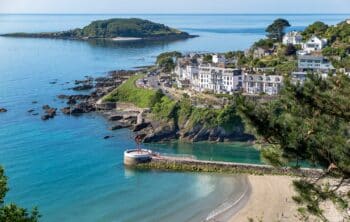Which beaches in Cornwall have Blue Flag status?
Cornwall is surrounded by the sea on three sides and with almost 300 miles of coastline, so it shouldn’t come as a surprise that the county is home to some of the best beaches in the world. In fact, the outstanding beaches are often the main reason for people to come down and stay in holiday parks in Cornwall.
One way that world-class beaches are identified is whether they have been awarded prestigious Blue Flags and there are nine beaches in Cornwall that have been given this status.
This guide takes a look at what you need to do to become a Blue Flag beach and which beaches have been awarded this special status in Cornwall.
What is a blue flag beach?
The iconic Blue Flag is an award given to beaches, marinas, and sustainable boating tourism operators. To be awarded this status, a series of stringent environmental, educational, safety, and accessibility criteria must be met and maintained.
The beaches that are given Blue Flag status in the UK are the pick of the crop for facilities, seasonal RNLI lifeguard cover and cleanliness.
Beaches in Cornwall with Blue Flag status
- Gyllyngvase Beach
- Great Western Beach
- Porthtowan Beach
- Porthmeor Beach
- Widemouth Bay
- Trevone Bay Beach
- Crooklets Beach
- Polzeath Beach
- Carbis Bay Beach
Gyllyngvase Beach

Gyllyngvase Beach, or Gylly Beach as it is referred to by locals, is Falmouth’s largest beach and is just a short 10-minute walk from the centre of the town. The beach is popular year-round and this can partly be attributed to the great amenities on its doorstep such as the Gylly Beach Café.
If you want to try an activity when you visit the beach, then there is paddleboarding, kayaking and coasteering on offer. Alternatively, you can just relax and enjoy the spectacular views of Pendennis Castle and the Lizard Peninsula.
Frankie, author of the Meet Me By The Sea blog, told us why she loves Gylly Beach: “Personally, I absolutely adore Gylly Beach in Falmouth! I went to university in Falmouth, so Gyllyngvase holds a special place in my heart. It’s a really sociable beach with lots of activities such as volleyball, kayaking and stand-up paddleboarding to enjoy. There are several places to grab a coffee or a bite to eat, as well as a few different walks around the coast to Swanpool or Castle Beach.”
Melissa Carne runs her own Cornish lifestyle and travel blog and she also highly recommends visiting Gylly Beach if you get a chance.
“What I love about Gyllyngvase Beach is that it’s in a really accessible location with it only being a short walking distance from Falmouth town centre, the university and the train station. It also has lots of close amenities such as a car park, restaurant, water sports hire and public toilets.
“I would recommend people to visit Gyllyngvase Beach if they are in the Falmouth area as it offers spectacular views of Pendennis Castle. It’s also a very safe beach which is great for families with young, elderly or disabled members.”
Great Western Beach
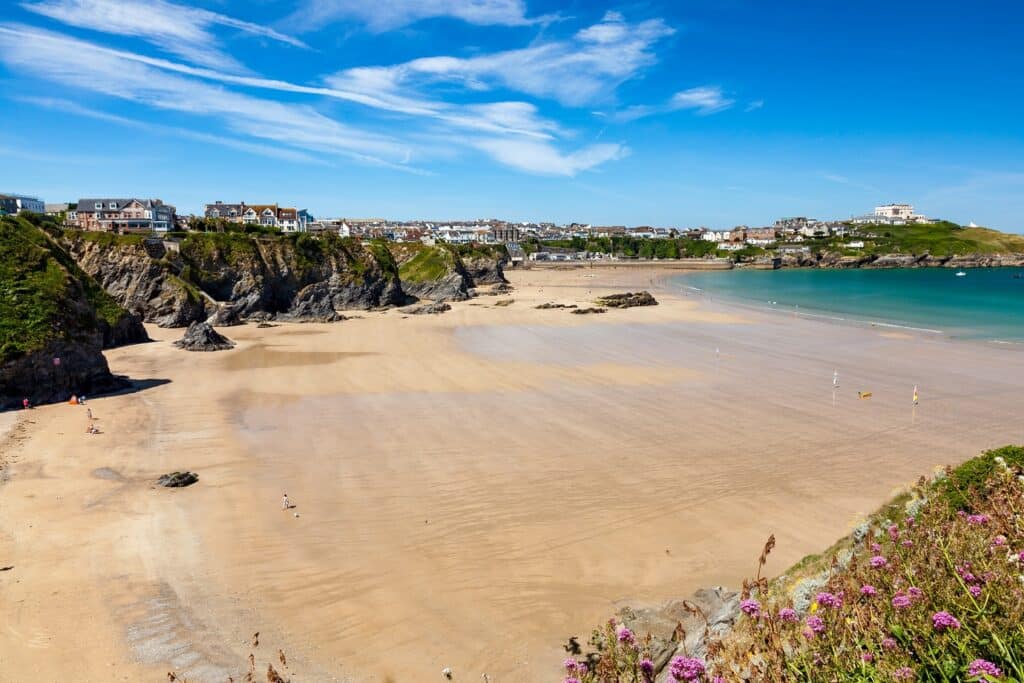
The Great Western Beach is a relatively new addition to this list after it was awarded a Blue Flag for the first time in May 2018.
Easily accessible from Newquay, the beach is very popular with surfers and families who come and enjoy the great waves, rock pools and the caves that are hidden away in the surrounding cliffs.
Lee from Great Western Beach told us a bit more about the beach and why you should come and visit when you are down on holiday in Cornwall.
“Great Western Beach is Newquay’s hidden gem. Its charm is in its seclusion and enclosed and sheltered nature, making it a firm favourite with local families and novice surfers.
“At Great Western, there is something for everyone. Dine out at the awesome Great Western Beach Café, with Californian-inspired dishes and stunning views, grab a beer on the sand at the Surf Shack, or learn to surf with NQY Surf School; Great Western is THE choice for a day out at the beach.
“Did you know that Great Western is Newquay’s original surfing beach?”
Porthtowan Beach

One of the most popular beaches for surfing in Cornwall, Porthtowan Beach boasts soft golden sand and is situated within an Area of Outstanding Natural Beauty.
There are dramatic cliffs that you can look at in awe, big sand dunes that are great places for children to play and the large expanse of sand is perfect for a game of cricket or beach football. When it is low tide, you can even walk to the adjoining beach just down the coast at Chapel Porth.
There is full lifeguard cover from the beginning of May until the end of September and during the October half term. There is lifeguard cover during weekends in October too.
The village of Porthtowan is full of cafés and restaurants so if you stay on the beach all day you have lots of choices if you are wanting to get some food.
Porthmeor Beach

Porthmeor Beach is just a short distance away from the centre of St Ives and its trendy cafés and shops. The beach itself is next to the famous Tate St Ives gallery and is a popular destination for surfers and swimmers alike.
The beach has won countless awards for its superb water quality and with lifeguards patrolling the sea from Easter to autumn, it is the ideal destination to visit for families.
There is plenty to keep you occupied when you visit as you can try surfing and take lessons with the St Ives Surf School or try other water sports with them. If you’d rather enjoy a bite to eat and drink and to just relax then you can at the Porthmeor Beach Café.
Widemouth Bay
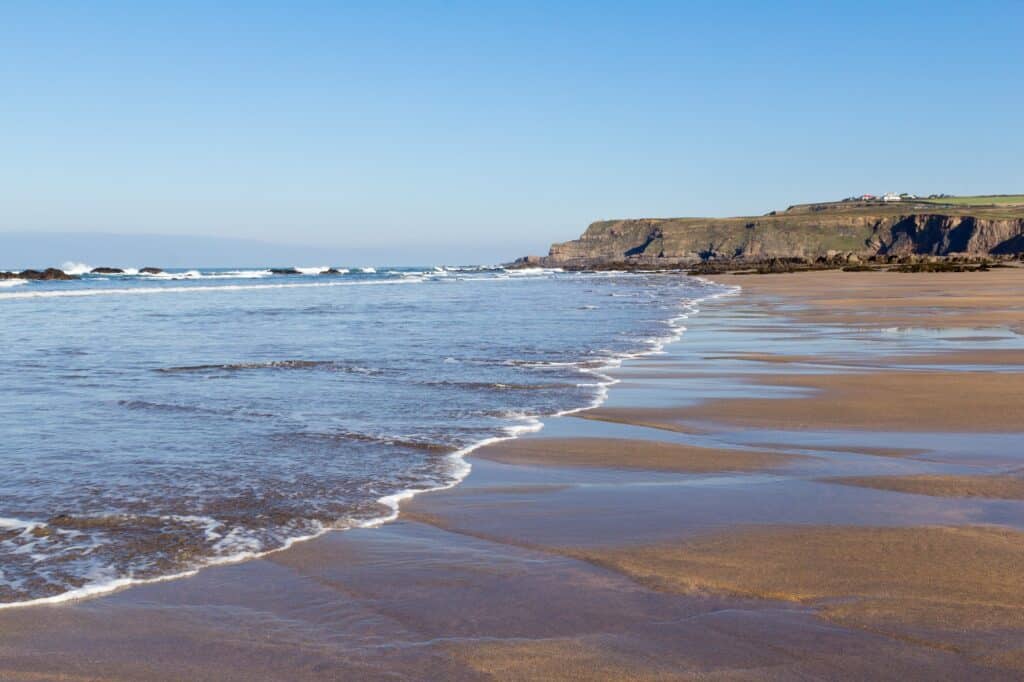
Just three miles south of Bude is Widemouth Bay and it is a hugely popular beach for surfers as the fantastic conditions make it an ideal location for both experienced surfers and beginners.
It is home to an array of local surf schools and there are lots of areas along the bay that offer the perfect environment for people learning to surf or body-board.
If water sports are not for you, then Widemouth Bay has lots more to offer. You can just relax and take in the stunning panoramic views of the coastline from the viewing areas at the north and south ends of the bay or visit one of the eateries that are within walking distance from the beach.
Lauren Beardsley, who is the writer behind the All Things Devon blog, has visited Widemouth Bay on multiple occasions and she told us why she loves the area.
“I love Widemouth Bay – the huge expanse of golden sands and openness of the ocean often draws me there. Even on a windy winter’s day, I like to sit and watch the waves smash into the shore from the comfort of the car (with a hot chocolate from the nearby cafés in hand!).
“I’d highly recommend visiting Widemouth as there is something for everyone. Whether you like relaxing on the beach or getting active in the surf, you’ll be perfectly placed in this popular spot.
“If you like getting your hiking boots on then Widemouth Bay is an excellent starting point for those seeking a circular walk to Bude. You’ll weave around the tall and dramatic coastline where you can admire the blue hues of the sea from great heights.”
Trevone Bay Beach
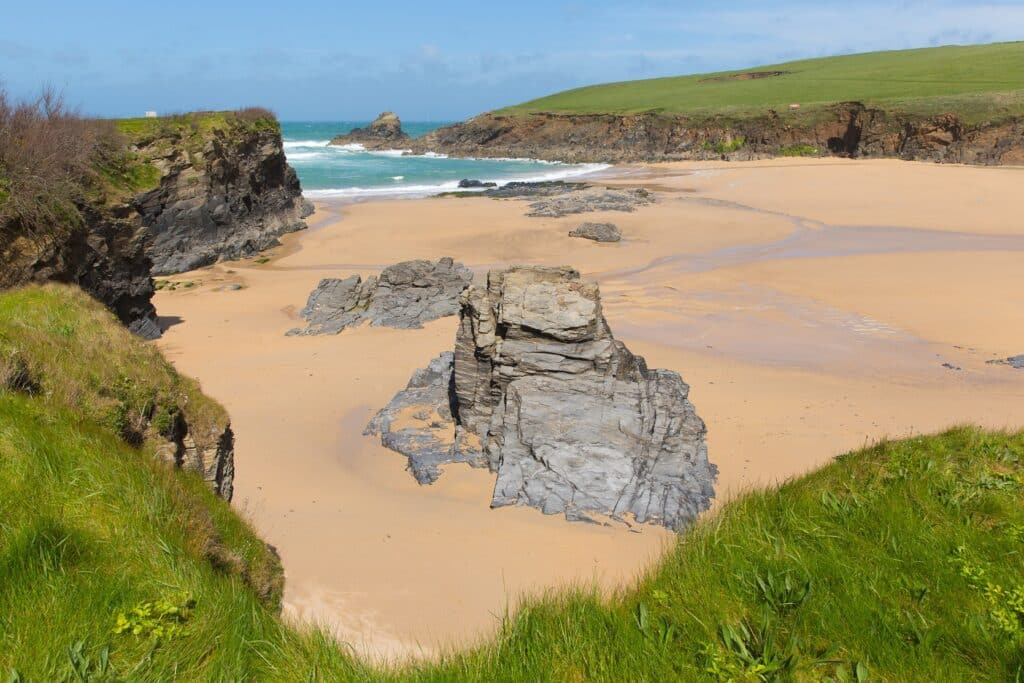
Just a couple of miles from Padstow is Trevone Beach and it has picked up Blue Flag Award due to its excellent facilities and its great water quality. Trevone is a golden sandy beach that is surrounded by high cliffs on one side and on the other side, there is a large rocky ledge that is known as Trevone Rock Beach by locals.
The area doesn’t just boast outstanding natural beauty, but it is well-known amongst keen hikers and walkers as there are lots of clifftop walks that lead towards Padstow in one direction and Trevose Head in the other. The famous ‘Blow Hole’, a natural attraction that was formed by a collapsed sea cave, is also something that makes this area unique and can be seen from the cliffs surrounding the beach.
If you are visiting the beach with your family then the nearby facilities, easy access to the beach and water sport activities that you can enjoy will ensure you enjoy a great day out. There are also lots of great rock pools that you can explore, so make sure you keep your eyes peeled for the sea life living in them.
Crooklets Beach
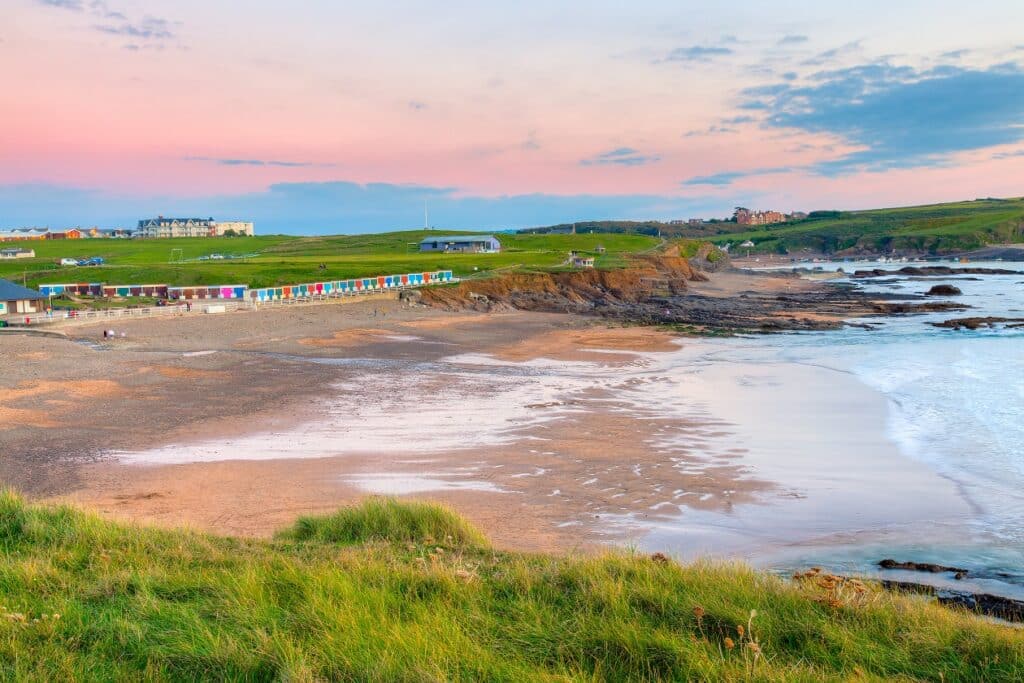
Crooklets Beach is one of three beaches that is located within the town of Bude and with a large expanse of golden sand that is bordered by rocky outcrops, there is ample opportunity to go rock pooling.
You can also try a number of watersport activities such as surfing and kayaking at Crooklets and enjoy delicious food at Rosie’s Kitchen and Crooklets Beach Café which are just a stone’s throw away from the beach.
There is a whole host of walks that you can enjoy from Crooklets Beach and when the tide is out you can make the short walk along the sand to the neighbouring Summerleaze Beach or the longer walk north to Northcott Mouth. If the tide is in, you can also walk to these beaches along the coastal paths along the top of the cliffs.
Crooklets Beach is also a short walk from the town centre of Bude so there are lots of amenities should you need to pick anything up or you’ve forgotten your bucket and spade!
Polzeath Beach
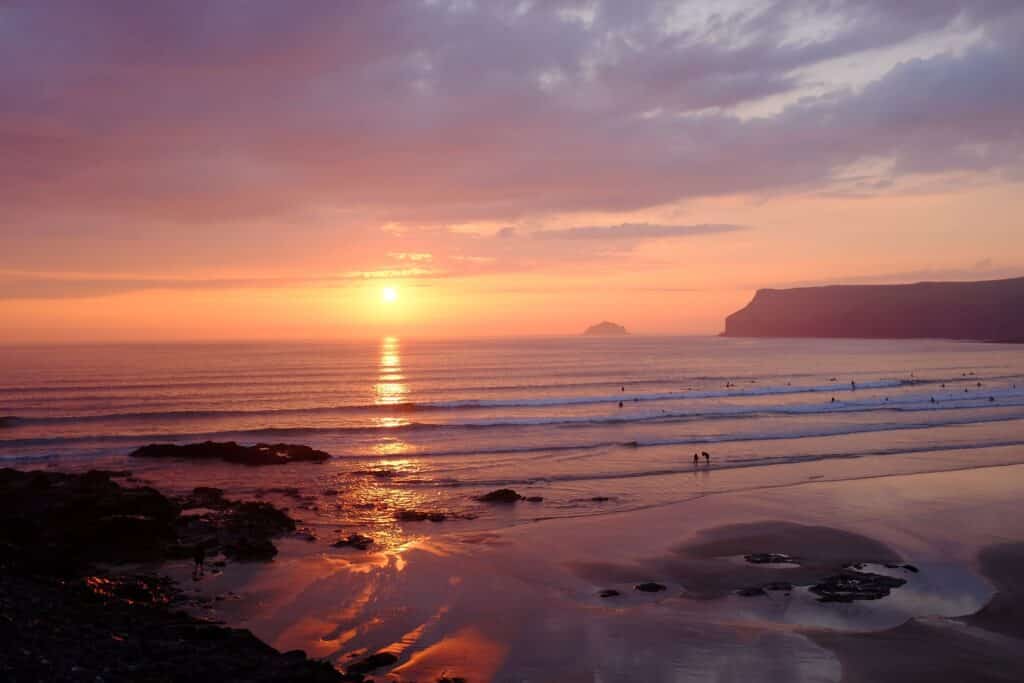
Polzeath Beach is on the north coast of Cornwall, and it is one of the county’s most popular beaches as it attracts surfers and holidaymakers from across the country.
When the tide is out there is a huge expanse of sand that stretches around half a mile so there is lots of space to play ball games and build sandcastles. The beach is also one of the safest as it has seasonal lifeguard cover and with its water quality and facilities that you would expect from a Blue Flag beach, it is no wonder Polzeath is so popular.
Polzeath is just north of the Camel Estuary and is just two miles from Padstow so you can always plan to stop off there for dinner before heading back to our Looe holiday park.
Carbis Bay Beach

Carbis Bay hit the headlines in June 2021 after it played host to the G7 conference of world leaders, but something else that it was awarded in the year was a Blue Flag.
The Carbis Bay Beach is just a mile from St Ives and whilst it has very little surf, it is an ideal spot for families with small children to go swimming in the sea. This beach regularly features in lists about the world’s best beaches as the golden sand, turquoise waters and the sub-tropical plants that surround the bay make it a picturesque spot.
There are also some great walks that you can enjoy in the area. There is a short walk on the east side of the beach at low tide that brings you to Porth Kidney sands where you’ll find an RSPB bird sanctuary and there are other routes up and down the coast. There is also a lifeguard service that runs from July until September.
This article features all of the beaches in Cornwall that have been awarded Blue Flag status and what makes them so special. If you want to read more articles like this, then take a look at our blog section.





